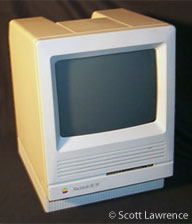I recently "kluged" a battery (two actually) for an old PowerBook 190CS. I tore apart the old
battery case and stuffed it with 12 AA NiMH batteries I bought at a
local CVS pharmacy. I included the old overheating sensors, etc. I also
had to build up a replacement PRAM battery (that center-tapped 6V
lithium rechargeable) with four AAA NiMH cells in a case (the PRAM
apparently doesn't care about the difference between 5.4 and 6 volts).
It hangs on the side of the battery slide. (Actually I found that 8 of
the original slightly oversize AA NiMH were still okay and
rechargeable.)
The machine operates pretty well; however, it has to be kept plugged
into the AC adapter. The batteries tend to self discharge and won't
start up the system if I leave it unplugged for more than a day or so -
even when shut down. The sleep mode works okay.

I still have a Mac SE/30
that has a bad internal hard drive, but also an outboard external one
that works. I will have to start it up someday.
Keeping Old Macs Running
I used to be (still am, actually) in charge of the Prescott, Arizona
Macintosh User Group recycling project, so I saw a lot of older Macs
come through, and we usually got them working again. We gave them to
organizations like Big Brother/Sister and individuals that needed
them.
Most were easy to work on. A Performa
6400 with a TV tuner made a great TV/cable set, among other things.
I still use a Power Mac
6100/60 AV as a monitor for a VHS recorder. A couple models were a
real pain (the 6500 and 8500 come to mind - you have to disconnect mother
board cables to even expand memory; they ended up at the computer
abbatoire).
 Recently I received a Blue iMac G3 with 1 GB
memory. To my surprise I found it could run Tiger (Mac OS X 10.4) very
well. I put a library program into it for use at a local church. Note
that the slot-loading iMacs that
have a FireWire port and the little door in the bottom to get at
memory/AirPort board/battery (if you have small fingers) are desirable
older machines. The older tray-loading iMacs are seriously
limited.
Recently I received a Blue iMac G3 with 1 GB
memory. To my surprise I found it could run Tiger (Mac OS X 10.4) very
well. I put a library program into it for use at a local church. Note
that the slot-loading iMacs that
have a FireWire port and the little door in the bottom to get at
memory/AirPort board/battery (if you have small fingers) are desirable
older machines. The older tray-loading iMacs are seriously
limited.
Third-Party Peripherals
My biggest gripe about Apple Inc. and Apple dealers is that they
have never made an attempt to reconcile the many devices available
through such outlets as Staples, Best Buy, etc. as to Mac
compatibility. For example, wireless routers and links are all
specified for Windows. The "Wizard" on the disk that comes with them is
for Windows. Buried on the disk is a PDF user guide which usually on
one line somewhere mentions that they can be used with Macs, but you
have to set them up manually. (This was true for a Linksys Router which
I bought from a Macintosh retailer in the area. No one ever
bothers to write up a one- or two-page outline of what information
there is applicable.)
David (also sometimes referred to as General Lud)
PS: I'm writing this on a Beige G3/266
MHz with 288 MB RAM running Mac OS X 10.2.8.
Share your perspective on the Mac by emailing with "My Turn" as your subject.


 Recently I received a
Recently I received a 
